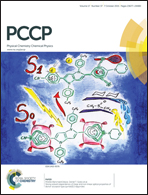Adsorbing a PVDF polymer via noncovalent interactions to effectively tune the electronic and magnetic properties of zigzag SiC nanoribbons†
Abstract
On the basis of first-principle computations, we first propose a simple and effective strategy through surface-adsorbing a poly(vinylidene fluoride) (PVDF) polymer via noncovalent interactions to tune the electronic and magnetic behaviors of zigzag SiC nanoribbons (zSiCNRs). It is revealed that depositing the strong electron-withdrawing PVDF polymer with a permanent dipole moment can induce the evident change of the electrostatic potential in the substrate zSiCNRs, like applying an electric field. As a result, this kind of noncovalent surface-modification by a polymer can break the magnetic degeneracy of zSiCNRs independent of the adsorption type and position, and sole ferromagnetic metallicity and even antiferromagnetic half-metallicity can be achieved. Moreover, all PVDF-modified zSiCNR systems can exhibit considerable adsorption energies in the range of −0.436 to −1.315 eV, indicating that these joint systems possess high structural stabilities. These intriguing findings will be advantageous for promoting excellent SiC-based nanomaterials in the applications of spintronics and multifunctional nanodevices in the near future.


 Please wait while we load your content...
Please wait while we load your content...